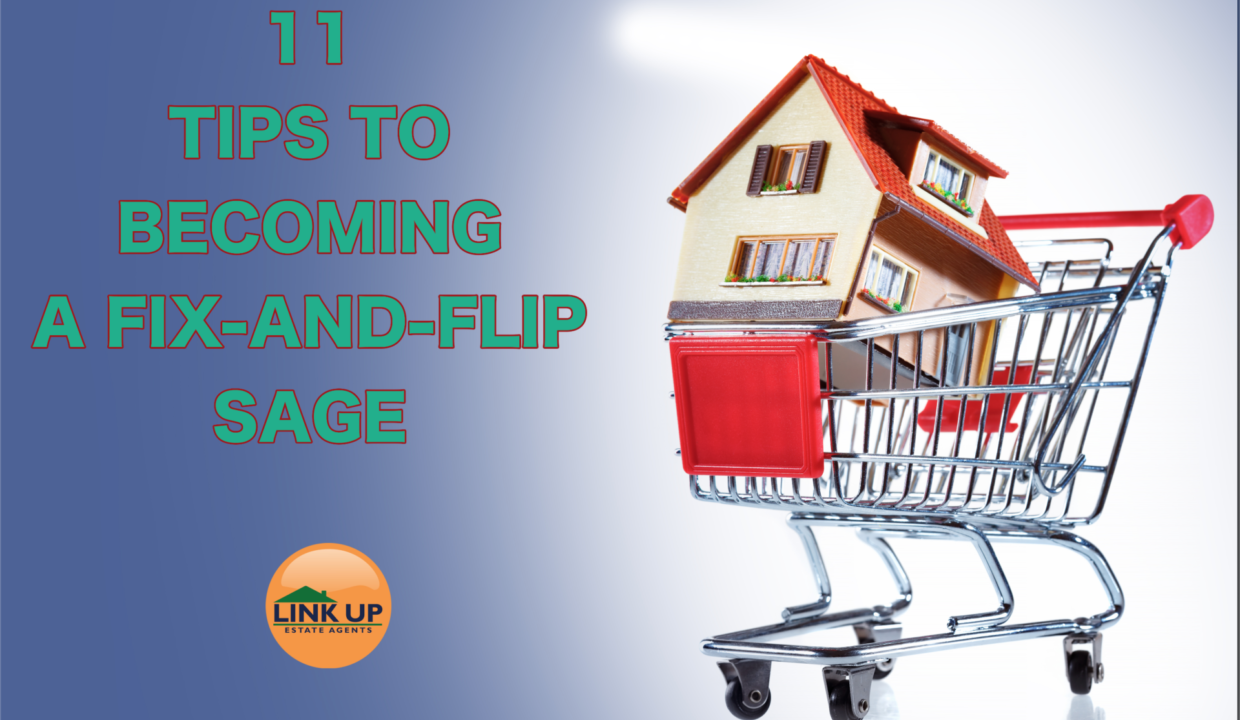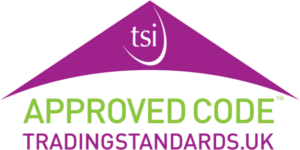
11 TIPS TO BECOMING A FIX-AND-FLIP SAGE
The old Fix and Flip, this has been a thing in real estate for years but many do not understand how and when this type of profit-making machine should be used, today we go over the 11 tips to consider
WHAT IS HOUSE FLIPPING?
House flipping is when real estate investors buy homes, usually at auction, and then resell them at a profit month down the road. Can you make money doing this? Yes. Can you make a lot of money doing this? Yes. But you can also lose everything you own if you make a bad decision.
Risk vs. Reward
Imagine buying a house for £200,000, investing another £25,000 in renovations, and then…nothing. No one wants to buy it. You now have to pay for your own rent or mortgage, plus the mortgage for your flip property, as well as utilities, home insurance, and property taxes. You might also have to pay for home staging and realtor fees when the house finally sells. All of this cuts into your potential profit.
According to CNBC, house flipping is now the most popular it’s been in a decade, yet the average return for flippers is lower than in previous years. Thanks to a hot housing market that’s raising prices, low inventory, and soaring rents (which drive even more people into home buying), the risk involved in buying. It’s getting harder to make huge profits.
The average gross profit on a house flip is presently at £42,725. That’s more than many people make in a year, and it lures plenty of newcomers who dream of quitting their jobs and becoming full-time investors. However, the investors making this much money really know what they’re doing — and even they still loose sometimes.
We found out that in 2016, 12% of flipped homes sold for break-even or at a loss before all expenses. In 28% of flips, the gross profit was just less than 20% of the purchase price. According to RealtyTrac senior vice president Daren Blomquist, 20% is the minimum profit you need to at least account for remodeling and other property costs.
HOUSE FLIPPING REQUIREMENTS
If you’re still reading, it means you’re not scared by the high risks of house flipping. Here’s what you need to get started.
Great Credit
You can’t get into house flipping with lousy credit, end of story. Unless you have enough cash to pay for a home and all necessary renovations, you’ll need some kind of loan. And lending standards are tighter than they used to be, especially if you want a loan for a high-risk house flip.
Your first step is to check your credit report to find out your score. Federal law allows you a free credit report from each of the three national credit reporting companies every 12 months, so this won’t cost you anything.
If you don’t have great credit, it’s time to start building a great credit score now. Pay your bills on time, pay down your debt, and keep your credit card balances low. There are plenty of other ways you can quickly improve your credit score so take the time to do everything you can. The higher your credit score, the better interest rate you’ll be able to get on a home loan. This can save you thousands when you start house flipping, freeing up more of your money to invest in the house itself.
Last, make sure you know affects your credit score in a negative way. For example, taking out too many credit cards at once lowers your score. You don’t want to do anything to hurt your score in the months before you apply for a loan.
Plenty of Cash
If you want to flip a house, you need cash. New investors get into financial trouble when they buy a home without a sizable down payment, then use credit cards to pay for home improvements and renovations. If the house doesn’t sell quickly, or if renovations cost more than expected, suddenly the investor is in way over their head.
Don’t be that guy. If you want to flip successfully, you need plenty of cash on hand. Most traditional lenders require a down payment of 25%, and traditional lenders are where you’ll get the best rate. When you have the cash to cover a down payment, you don’t have to pay for private mortgages or PMI. Most PMI costs between 0.5% and 5% of the loan, so having to pay this each month can really cut into your profits.
Loans for flips also have higher interest rates. Most investors take out an interest-only loan, and the average interest rate for this type of loan is 12% to 14%. In comparison, the interest rate for a conventional home loan is typically 4%. The more you can pay in cash, the less interest you’ll incur.
There are several ways to build cash in your savings account. Use an auto saving plan or set up a standing order with your bank to make saving money each month effortless. You can also look at various other side income businesses then use this money to build your cash reserves for an investment.
If you’re buying a foreclosure from a bank or through a real estate auction, another option if you qualify. If you have enough in savings and manage to find a bargain-priced home, you can buy the home and then take out a small loan or line of credit to pay for the renovations and other costs.
WHAT MAKES A GOOD REAL ESTATE INVESTMENT?
Not every house makes a good flip. Just because a home is selling for a rock-bottom price doesn’t mean you can put money in it and automatically make a fortune. Successful flippers are very discerning about the homes they choose to invest in. Here’s what should you look for in a potential house flip.
Great Location
Expert house flippers can’t stress this enough. Find a home in a desirable neighborhood or one that’s on its way up. You can improve a house all you want, but it’s next to impossible to improve the personality and safety of a neighborhood on your own.
Start by checking on your borough’s website. Look for areas with rising real estate sales, employment growth, and other indications the town is thriving. Avoid neighborhoods with a high number of homes for sale; this could be a sign of a depressed local economy or a sign that neighbors are leaving due to crime or development.
Next, research the safety of each neighborhood you’re considering. Homes located in or near high-crime areas will be next to impossible to sell at a profit. That said, there are also some markets that show signs of over-investment. This means inventory is so low and demand is so high that flippers are paying above-market prices for homes, which can drastically reduce net profit. some hot markets include
- Peckham, South London – Increase of £325,000
- Westminster, Central London – Increase of £242,500
- Chiswick, West London – Increase of £75,00
- Hampstead Heath, North London – Increase of £250,000
- Silvertown, East London – Increase of £195,000
If you’ve found an affordable home in a neighborhood that’s on its way up, your next step is to research the local schools. Homes in good school systems sell faster, and command higher prices, than homes in mediocre or poor school systems.
When considering an investment home’s location, you also need to think about its proximity to your primary residence. Remember, you’ll be working on this house daily in the weeks and months to come. Don’t invest in a house too far away from where you live or work; you’ll spend more money on gas and it will take longer to fix up.
Sound Condition and the Right Renovations
If you’ve ever done a home renovation project, you know some nasty surprises can be lurking just below the surface. And nasty surprises like black mold or a cracked foundation can ruin you financially.
Look for structurally sound homes, especially if you’re considering buying an older home. You may not have the opportunity to have the home inspected especially if you buy it at a real estate auction. So you need to learn what to look for or bring someone knowledgeable about building, electric, and plumbing to look at the home with you and determine if it’s a good buy.
Focus on homes that only need some quick updates to resell. Refinishing kitchen cabinets, adding new hardware, fixing up the yard, and updating paint and carpeting are all relatively inexpensive projects that can transform a home. Decorating the home based on the taste of your prospective buyers is also important
What should you avoid? A house that has mold or needs a roof replacement or needs rewiring will require some serious time and cash to update and sell. Make sure you know which updates and repairs you can afford to make, which repairs you can’t afford, and which home improvements would increase the pricing of the house. Bear in mind that some home improvement do not or reduce the value especially in antique homes
When you estimate the cost of any job, experts advise adding 20% to the final total as it will always cost more than you think it will.
Last, when considering a home, don’t forget to factor in the cost of building permits. These can cost anywhere from a few hundred up to several thousand dollars, depending on the type of work involved and the city you’re in. Not accounting for permit costs is a rookie mistake that can quickly ruin your renovation budget.
Market Value
Make sure the price of the home is below its value on the local market. Try to buy the worst house in a great neighborhood, versus the best house in a lousy neighborhood. The worst house in a great neighborhood has nowhere to go but up in value, due to the value of the other homes in the area.
Although you can search the web and see millions of foreclosed homes for sale, never buy a home without seeing it in person. This is the biggest mistake new flippers make. Keep in mind that an online photo gallery only tells part of the story. Out-of-date photos, awful neighborhoods, and black mold are just a few of the horror stories of foreclosed homes found online. Always investigate a property yourself before you decide to buy.
When you buy a home to flip, it’s important not to over-value the home by investing too much in the renovation. You want to improve it just enough to make a healthy profit and keep it on par with what’s selling in the neighborhood. If you put too much into the home, you won’t make your money back.
HOW TO FLIP A HOUSE
If flipping were as easy as finding a cheap house online, buying it, and selling it for a profit, we’d all be real estate billionaires. You must educate yourself before you even start looking at homes. Here’s what you need to know.
1. Learn Your Market
First, research your local real estate market. Where do people want to live right now? What kind of house do people want to buy right now? Don’t speculate about up-and-coming neighborhoods. Remember, you want this house sold fast.
2. Understand Your Finance Options
Next, become an expert on home financing options. Will you buy a house with cash? Will you apply for a home mortgage loan or take out a HELOC? Make sure you understand the ins and outs of home financing before you apply for a loan or make an offer on a house. This will allow you to make the best decision for your circumstances.
3. Follow the 70% Rule
Analyze how much house you can afford and how much you can afford to lose on any deal. Experienced flippers follow the 70% rule when analyzing how much they’re willing to pay for a house. This rule states that investors should pay no more than 70% of the after repair value (ARV) of a property minus the cost of the repairs needed.
Let’s say a home’s ARV (or value after necessary repairs) is $200,000, and it needs $30,000 in repairs. The 70% rule states that you should pay no more than $110,000 for this home:
$200,000 (ARV) x 0.70 = $140,000 – $30,000 (repairs) = $110,000
This rule is a good guide to follow when you first get into house flipping as it can help you avoid overpaying for a home.
4. Learn to Negotiate
The less money you invest in a house, the more money you can earn during the flip. Good negotiation strategies will help you effectively haggle with contractors and other workers.
5. Learn How Much Average Projects Cost
Do you know how much it costs to recarpet a 1,000-square-foot home? Rewire a house? Build a deck? Landscape a yard?
Every project is different, but with some experience, you can learn how to estimate the costs of many home renovations and get an idea if a particular home is a good buy or not. One of the best ways to build your experience with this is to do some renovations on your own home. This can also give you a general idea of the type of projects you like to do and which projects you’re better off hiring out.
Know which home improvements increase a home’s value and focus on these projects first. These might include upgrading kitchen appliances, repainting the home’s exterior, installing additional closet storage space, upgrading the deck, and adding green energy technologies.
6. Network with Potential Buyers
Network extensively and talk to potential buyers before you even start looking for a house to flip. Do whatever you can to build relationships with future buyers. If you have a buyer lined up when you purchase an investment home, the home sells as soon as the updates are completed.
You can also save money long-term if you take the time to get your realtor’s license, which will enable you to broker your own deals and avoid paying another agent.
7. Find a Mentor
If you know a successful house flipper, ask if they’d be willing to mentor you. You might even want to consider offering this person an incentive to be your mentor.
For example, ask if they’ll mentor you in exchange for a small percentage of your first successful flip. This way the mentor is motivated to tutor you, and you’ll be sure to get a high-quality education. Offering a financial incentive also enables you to approach experts you don’t know personally since being compensated for their efforts will make them more receptive.
8. Research Listings and Foreclosures
Many websites provide foreclosure listings. You can also find foreclosure listings through real estate company websites, Under search filters, select the option for “foreclosures.”
Your local newspaper is another source of foreclosure listings. Legitimate auctioneers put notices in the legal section of local papers, and you can usually find their specific listings by visiting their websites.
Another way to find foreclosures is through a bank. Search for a particular bank along with the letters “REO,” which stand for “Real Estate Owned.” This simply means that the homeowner no longer owns the home; the bank does. This search will take you directly to each bank’s foreclosure listings.
Once you find a home you want to buy, check out its background most sites provides a comprehensive background check on a home. You can review extensive details about the home’s history, including repairs, remodeling, and additions. This can help save you money.
For example, let’s say you want to buy a home whose listing indicates its furnace was replaced 10 years ago. When you run a report on BuildFax, you learn the furnace is closer to 20 years old. You can now go back to the seller and negotiate a much lower price.
9. Make an Offer
Once you find a home you like, it’s time to make an offer If it’s a great house selling for a low price, you might have competition. For many flippers, flipping is a full-time job, and they will likely know about this house too. You can sneak by the competition by targeting a neighborhood and going door-to-door making offers.
Before you make an offer, make sure you know the highest price you can pay for a house and still make a profit. This includes your estimate for repairs, interest, and taxes. Remember to pad your estimate by 20%. If the homeowner or bank won’t sell to you for this price, walk away. It’s better to keep looking than risk going broke from a bad investment.
10. Find Good Contractors
If you have some solid DIY skills, you might opt to do some or most of the renovations yourself. This can save you a significant amount of money – if you know what you’re doing.
Knowing whn its necessary to cut costs with DIY or calling a contractor is crucial. You should only tackle projects you’re sure you can do well and on budget. For projects you can’t do on your own, you need to Find a great contractor
A general contractor, or GC, is a building professional who manages the whole renovation project and hires their own subcontractors to do the necessary work. Hiring a GC can be expensive; they’ll add 10% to 20% onto what their subcontractors charge when calculating your final bill. However, they can be worth their weight in gold if you find a great investment opportunity, can’t do the work yourself, and are willing to incur the extra expense.
A good contractor can help you avoid costly renovation mistakes and save you a significant amount of time on a project. This means you can get the house up for sale faster and make fewer mortgage payments. If you’re flipping a house while working a full-time job, hiring a GC is probably a necessity; someone has to be available at the house to oversee the work at least part-time, or the project will never get done.
A general contractor will also be in charge of obtaining the necessary building permits. This means their name will be on every permit, and they’re responsible for making sure the job is done right for every inspection. Make sure to apply for permits as soon as the sale is final to save time and get the process moving.
Start building a network of contractors you trust, including plumbers, electricians, and landscapers. When you interview a contractor, ask yourself the following questions:
- Did they arrive on time? Contractors who are habitually late will waste your time and slow up your renovation project.
- Do they have quality references? Ask for references and call them. If a contractor doesn’t provide references, don’t waste your time dealing with them.
- Did they reschedule your appointment multiple times? Again, if they have a problem with time management, it will affect your renovation.
- Are they organized? Disorganization wastes time.
- Can they supply a professional, accurate bid? Any bid they provide should be detailed and on paper. A verbal quote and a handshake won’t cut it with a flip, at least at the beginning of a relationship when you’re just learning whether you can trust this person.
It’s a smart idea to start building a network of quality contractors before you make an offer on a house. Remember, it can take a long time to find good help, and you don’t want to start this process after you invest in a home and are making two mortgage payments each month.
Keep in mind that most experienced flippers try to have a home bought, renovated, and relisted in 90 days. That’s a quick turnaround time, and for your first few flips, it might be out of reach. But the longer your home is tied up in projects, the less profit you stand to make; that’s why it’s so important to carefully weigh whether you should do the work yourself or hire help. Doing it yourself might save you money upfront, but if it takes you three times longer than a professional, it might not be worth it.
11. Relist and Sell
Many flippers end up listing their homes with a realtor. Realtors eat and sleep real estate, have access to buyers, and can list your house in the Multiple Listing Service (MLS) database. They also know the current market fluctuations and have the skills and network to get you the best price quickly.
You can also choose to sell the home yourself which is sometimes very difficult. You’ll save money in realtor fees, but in some markets, you might end up waiting a long time for the house to sell. In addition, listing and showing a house takes time. If you can’t be available every time someone wants to see the house and you don’t want to host open houses, working with a realtor might be the best choice for you.
FINAL WORD
There’s no doubt that flipping houses is a risky business. If you make smart decisions, you can make a lot of money flipping. But you can also lose everything if you make a bad investment. Also, read the tips on Striking gold in real estate
Before you get into the world of house flipping, do your research to make sure it’s right for you.
Have you ever flipped a house? What was your experience like? What do you wish you’d done differently? tell us below





